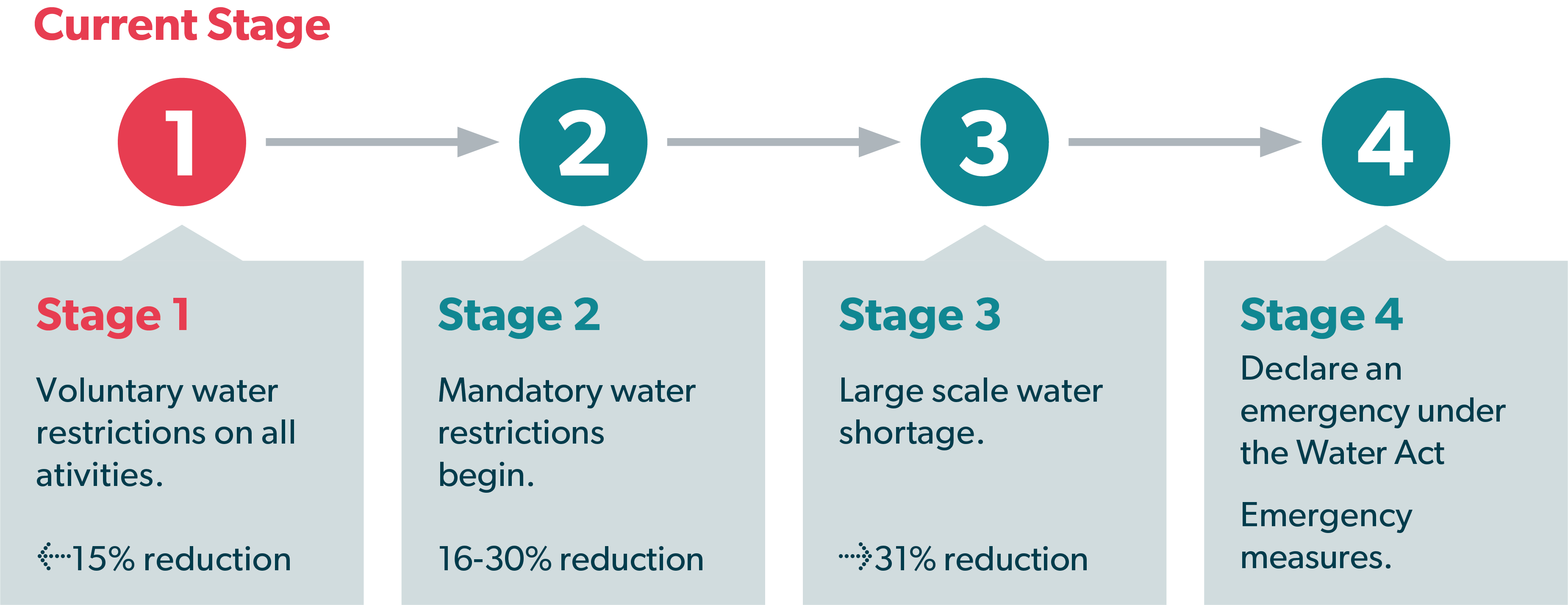WHY THIS IS HAPPENING
After several dry years without substantial precipitation, southern Alberta is facing potentially serious drought conditions in 2024. The Province, in collaboration with irrigation districts and the Municipal District of Taber, continues to monitor snowpack, precipitation and river levels in order to understand current drought conditions and ensure that water users have the information they need to be prepared. Recent snowfall and rainfall are encouraging, but reservoir levels remain well below normal. It is important to conserve the limited resources we do have.
All residents are encouraged to consider ways to use water wisely. Water conservation is a beneficial habit that supports our community and benefits Albertans downstream from our municipality. There are simple measures everyone can take to conserve water. Currently, the Municipal District of Taber is at Stage 1 of our Water Shortage Management Response Plan for Residential and Commercial Users, which is voluntary. We urge residents to be conscious of their water consumption and aim to reduce usage by up to 15%.
Below are links to resources meant to inform residents of current conditions, measures to conserve valuable water supplies, and information to help you navigate the anticipated drought conditions.
WHERE ARE WE CURRENTLY

Residents are asked to continue voluntary conservation measures. Ways to conserve water can include:
- Limiting all outdoor uses, including watering lawns and washing cars.
- Reusing water where possible.
- Minimizing shower times and bath levels.
- Running full loads of laundry and dishes.
What We Are Seeing
- Drought conditions remain "dry" with a higher-than-average risk of drought persisting this year.
- Natural river flows & mountain snowpack are low.
- A strong El Nino suggests we will experience a drier and warmer winter, impacting moisture levels.
How We Are Preparing
Monitoring Conditions
- Although the risk of drought is elevated at this time, conditions can change depending on the weather this spring and summer. We are closely monitoring conditions while taking steps to be prepared for drought, flood, or any other climate hazards such as extreme heat which can amplify drought, wildfires, and smoke hazards.
Working with Partners on Water Supply
- The MD of Taber is working with a number of partners to monitor conditions and respond accordingly. This includes the St. Mary River Irrigation District and the Government of Alberta.
Preparing for Outdoor Water Restrictions
- If southern Alberta continues to experience dry conditions, residents should be prepared for outdoor water restrictions, which may be needed to help conserve water. These restrictions could be in place earlier this season, for a longer duration, and could be more strict than typically seen in our region. We will keep residents and businesses informed as conditions evolve.
Important Links
Reservoir Levels (June 10, 2024)
Current Southern Alberta Reservoir Levels
(*as of June 10, 2024)
Oldman Reservoir
Current storage: 82%
Normal for this time of year: 86% to 94%
St. Mary Reservoir
Current storage: 78%
Normal for this time of year: 74% to 89%
Waterton Reservoir
Current storage: 85%
Normal for this time of year: 75% to 87%
Chin Reservoir
Current storage: 55%
Normal for this time of year: N/A
Grassey Reservoir
Current storage: 58%
Normal for this time of year: N/A
Water storage volumes in the major irrigation and hydroelectric reservoirs of the Oldman and Bow basins are updated weekly and available in the Provincial Reservoir Storage Summary.
Soil Moisture Levels
Alberta Agriculture and Irrigation produces a soil moisture report periodically during the winter months, with frequency increasing during the growing season.
- Soil moisture report (May 30, 2024)
Partner Resources
Provincial Resources
Alberta Drought Conditions Interactive Web Map January 2024 (plantmaps.com)
Alberta Water Council – Multi-Year Drought Resource Page
Building Resiliency to Multi-Year Drought | Alberta Water Council
Bow River Basin Council – Partner Resources Page
2024 Drought Information | Bow River Basin Council
